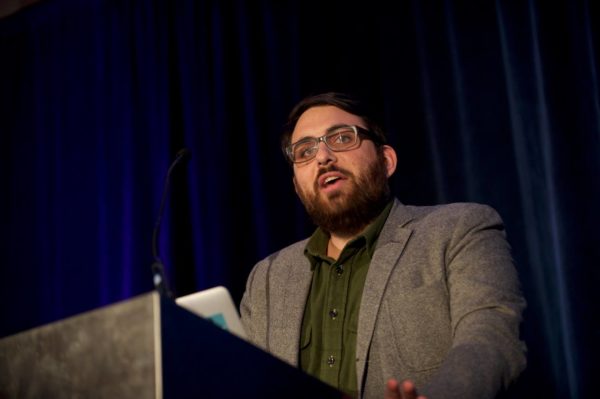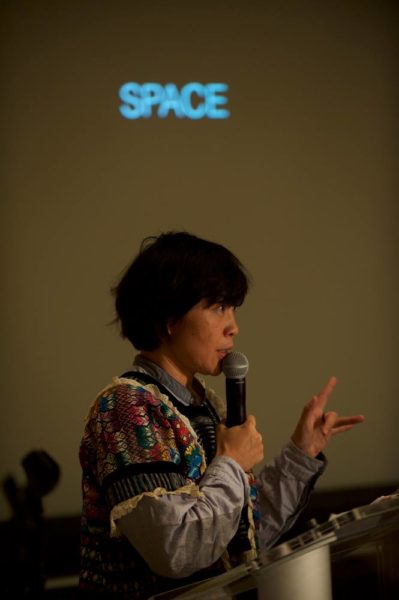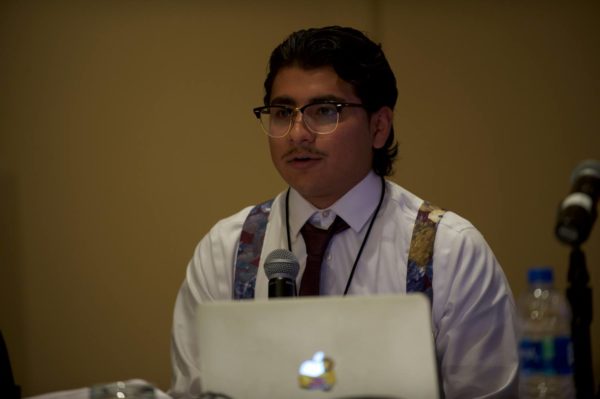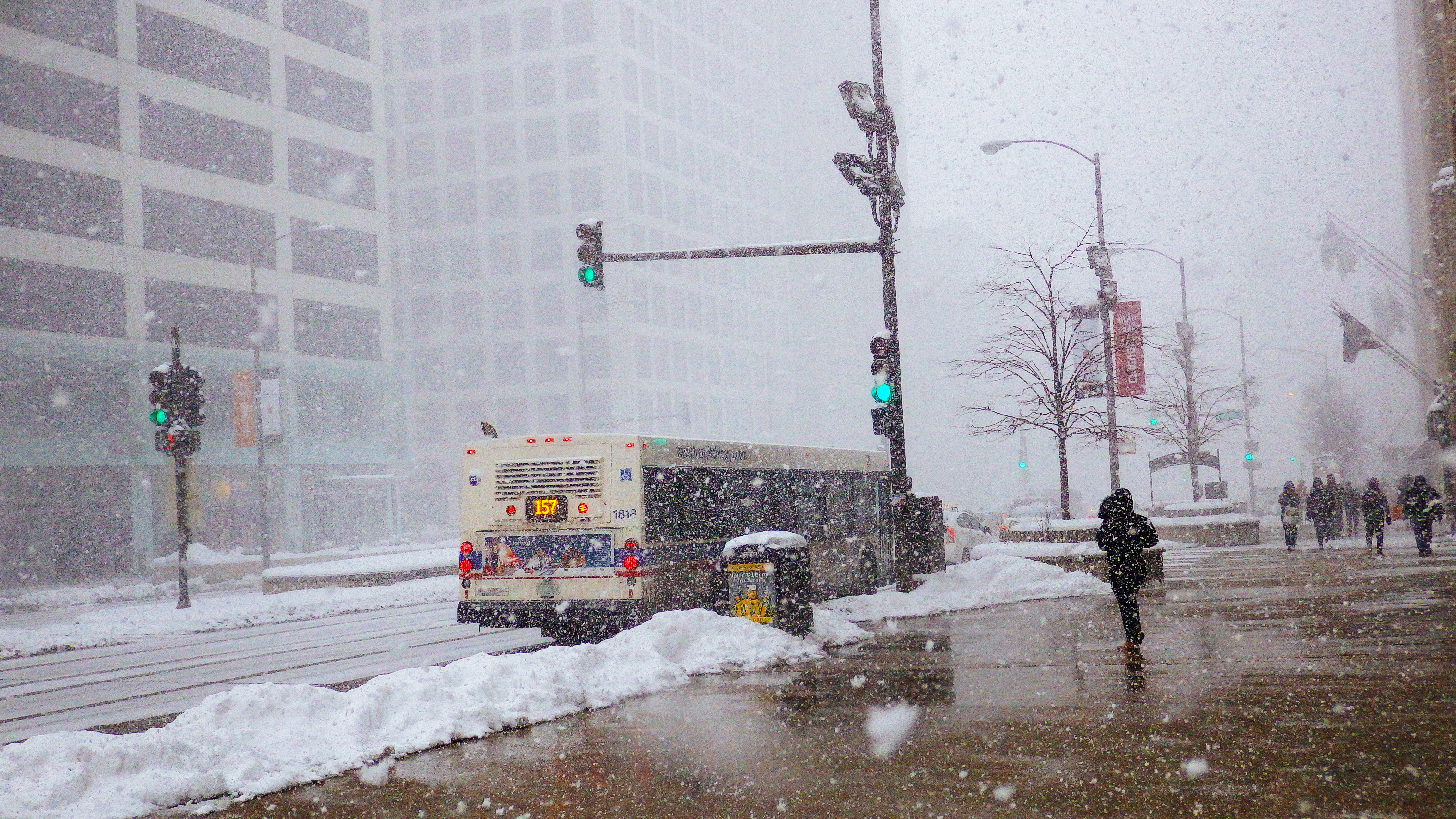I’m sitting in a late night coffee shop in Chicago’s Northern suburbs, reading through the long list of ideas, stories and names that I’ve collected over the whirlwind of the last four days. Each time the door opens, a cool Windy City breeze cuts through the central heating. It snowed here over the weekend – nothing novel for Chicagoans, but the Aussies all ran outside to marvel at falling snowflakes.
This was my first time attending the Third Coast International Audio Festival, now in its 17th year. After three days of back-to-back sessions, ‘unconferencing’ (meetups formed by like-minded attendees), live podcast shows and nights of networking drinks (including a ‘radio bash’ with a pumping DF), I’m ready to crash in an inspired, exhausted heap. I was awestruck from being surrounded by so many of my radio heroes, whose voices and stories I know so intimately, in a room full of 800 people passionate about audio storytelling. But I also had a real sense of being a visitor, looking in on a way of communicating, crafting and telling that felt both familiar and foreign.
I’m stoked to say that many of my introductions at Third Coast were met with sentiments like, ‘I love what is coming out of Australia at the moment’. Across the weekend there were shoutouts to Australian productions, like the Wheeler Centre and Behind the Wire’s The Messenger, Bec Fary’s SleepTalker, Wendy Zukerman’s Science Vs (Gimlet) and the ABC’s growing slate of podcasts. Sydneysider Rosa Gollan won Third Coast’s ‘Best New Artist’ award for ‘The Discussion’, her short piece produced for ABC RN’s PocketDocs. There are some wonderful Aussies making their mark on the industry over here.
American storytelling has been at the forefront of this ‘Second Golden Age of Radio’. And they’re bloody good at it, too. Just strike up a conversation in the line for a coffee or on the bus; everyone here seems to have a beautiful voice and a way with words, even if it’s just to tell you what they thought of the breakfast. In contrast, Australians tend to be a little more reserved and less practised in spilling our personal stories to strangers. In our radio and podcasting, consciously or not, the question often lingers: what sounds ‘Australian’ – and therefore how much can (or should) we adopt from American styles and structures?

Writing for the ear
Each year we’re seeing more podcast producers presenting at writers’ festivals and cultural events beyond traditional sound or radio circles, and audio storytellers are increasingly sharing audiences with writers of other media. How can we collaborate or draw upon the techniques of our filmmakers, writers, poets and performers? What can we take from the mythic first Golden Age of Radio, when families crowded around the wireless for radio plays and serials that lasted decades – and where entire musical theatre casts gathered in one room to perform for the airwaves?
On Third Coast’s opening night, Brian Reed wove us through three years of highs and lows creating the ‘novelistic’ S-Town, suggesting we should be thinking more like fiction writers with our form and narration – rather than repeating traditional, linear journalistic styles – in order to craft a story for a niche audience. A session called ‘Playing With Reality and Pushing the Boundaries’, led by Ann Heppermann (Sarah Awards) and Ellen Horne (EP of Original Content at Audible), asked why audio producers and consumers seem to put only nonfiction in our ears – while TV drama thrives. They explored fictional techniques like Andrea Silenzi’s invented character Randy in Why Oh Why, the use of human voices for non-human characters in Love+Radio’s ‘A Girl of Ivory’ episode, and the creation of a fictional host for NPR’s 1981 documentary ‘Father Cares: The Last of Jonestown’.
These were interesting examples to consider alongside reporting and documentary, but I wanted to hear the presenters’ thoughts on the development of audio fiction, too. What will it take to reach an audience the likes of S-Town or a television drama with a fictional audio story? A fellow audience member commented that he often feels he’s at the bottom of the ‘story hierarchy’ when pitching fiction. He asked how and if this was likely to change, but nobody really had an answer for him – other than that perhaps we’re just waiting for that breakthrough fictional series to come along and change our minds.
Sound and space
Two particular Third Coast sessions catered for producers interested in experimenting with sound and format. Chicagoan audio artist Stephan Moore presented his approach to generative sound design and site-specific installation, including a project which set out to transform highway noise pollution in Melbourne into an artistic experience. (The work was undertaken in collaboration with RMIT University.) Without a clear tie to the narrative storytelling that Third Coast audiences are accustomed to, the room slowly emptied. But the session should’ve been useful to people. It offered another perspective. It suggested different paths to meaning – or even a story. It encouraged us to think less about deliberate and specific production choices, and more about broader concepts and open-ended experiences – as well as the particular environments that such work can exist in and affect.

For those of us interested in experimental formats, hearing Canada’s Veronica Simmonds and Sook-Yin Lee discuss the process behind Sleepover was a highlight. This CBC podcast blurs performance art and ‘reality radio’, bringing three strangers into a room for a 24-hour sleepover (and yes, that’s 24 hours of tape!). They shared tips on their process – like making note of what each producer felt to be the most heart-wrenching moments as they were happening in real-time, as well as choosing clips that accurately depict their characters’ circumstances, based on the ongoing relationships and trust they had built with them. Lee emphasised the team’s commitment to sharing time and space with their characters, and the importance of forming relationships, enabling a space for people to become comfortable and share their truths. Lee always places herself in the situation with her guests, telling her stories as well. ‘People enter a space with their own values and ideas,’ she said. ‘If we’re asking people to share what makes them vulnerable, then we should too’.
Whose story is it anyway?
In Australia, we have different sensitivities around telling or hearing others’ stories. Our laws and ethics differ from America’s when it comes to recording with or without permission, or reporting on crime and suicide – leaving some Australian audiences uneasy about aspects of US podcasts like Missing Richard Simmons and S-Town. During a live Love+Radio show (part of Third Coast’s new fan-facing programme, The Fest), we heard an especially spiky, ethically dubious piece of tape. The show’s producers were debating whether to use it in an upcoming episode, so it was offered up for audience feedback – apparently without the interviewee’s knowledge. The event had our Aussie group riled up about who has the right to share and tell vulnerable stories – and how. We compared the process behind this particular interview to how it would unfold back home, with teams of researchers, legal advisers and fact checkers. We agreed that even with the interviewee’s willingness to share her experience, this piece of tape should remain unpublished.
The team behind Youth Radio, a nonprofit that puts young people at the head of the storytelling and production process, kicked off their session with a slide that read, ‘When you don’t look like the person whose story you’re trying to tell, you’re going to screw it up.’ Producer Noel Anaya won the room over discussing the making of ‘Emancipation’, a Third Coast Award-winning short feature about his experience divorcing the US foster care system. In an industry where reporters usually have final say in the story, this process stood out as brave, honest – and, some would say, risky. The Youth Radio team also pointed to their Growing Up Homeless series, throughout which they ensured the storyteller was at the head of any music choices, marketing and design – right through to having audience feedback passed along.

Telling the stories of other social or cultural groups was an important and recurring touchpoint of conversations at the Festival. John Biewen – the white American producer of Scene On Radio (lately celebrated for its ‘Seeing White’ series) – flagged it early on opening night, saying, ‘It’s not okay to have hoards of people who look like me doing most of the stories.’ Martina Castro of bilingual podcast production company Adonde Media challenged US producers to consider their Spanish-speaking audiences or neighbours by utilising bilingual producers or creating alternate language versions of their content. It’s particularly relevant in a country that has more Spanish speakers than Spain itself, but it’s also an interesting takeaway for Australia, with languages other than English that are in dire need of preserving; others that are increasing in prevalence, and stories that traverse linguistic or cultural groups.
On the other hand, through various sessions, we heard an array of suggestions for how to position yourself in a story. You could be a character (like Sook-Yin Lee is in Sleepover), or an interviewer recounting a story (thank you Ira Glass). Or you could develop your own style as a narrator. In a session on tracking (narration, hosting, voice links, etc.), Sean Rameswaram (of Radiolab spin-off More Perfect) reminded us that the advice is going to be the same from producers of all levels of experience: tell it ‘like you’re sitting around a campfire’. He threw to alternative narration techniques, referencing Brian Reed in S-Town or Scott Carrier’s Home of the Brave, and advocating for whatever style works best for the story you are conveying. The overall message from Rameswaram and other presenters was to put more of yourself in the story – to make yourself vulnerable, develop your own style and voice.
The role of the narrator
Presenting the Third Coast/Richard H. Driehaus Competition on Saturday night, Helen Zaltzman (The Allusionist) told us that as a Brit, she can’t deal with the emotional language and overload in American storytelling. She had us all laughing, but I could relate – after four days, I was feeling overwhelmed by it all myself, and wondering how this all translates for audiences back home. I found myself hungry for discussions around space and silence, conceptual and creative thinking with recorded and designed sounds, and ways of telling stories that aren’t jam-packed with dialogue or narration. In Australia, we so eagerly absorb American stories, protagonists and narrators (through our ears and eyes) – and yet it’s not necessarily a style that wholly reflects our own geography or cultures that aren’t centred around the individual.
Jad Abumrad’s recollections of how he began experimenting with deliberate silences and pauses within Radiolab stories – to catch a listener off guard – stuck with me. Through the weekend, his was the only advice I’d heard on the importance of sitting back and allowing silence, both in interviews and in the post-production process. He talked about how he loves Blade Runner’s use of ‘little shit’ – the knocks, fumbles, coughs, breaths and moments that fit around the main story or dialogue; stuff that would otherwise go unnoticed or typically be cut during an edit. He also spoke with humility and vulnerability of a time in his career when he was overworked and burnt out, living in the concrete dream-jungle of New York City – only ever experiencing the one block around his office, for his coffee and lunch. A surprise detour suggested by his producer one day took them unexpectedly through an underground sculpture house and opened his eyes to the ‘miracles of the ordinary’; when he came back to the street, he was blown away by something as simple as indoor plumbing. ‘Surprise was the first step to gratitude’, he said, adding that a problem he encounters too often is that people pitch stories they think are interesting – rather than those they really feel.
Bringing it home
It was incredible to have spent a weekend with so many people who share the same passion and excitement for sound and stories, all working in interesting ways. I met a woman who collaborates with local communities to make site-specific audio history tours of city streets, and a man who secretly makes guerilla commentary podcast tours of America’s highbrow cultural institutions. I met writers, filmmakers and artists coming to the audio world with a fresh perspective and different experience.
It’s a seriously exciting time to be in this game – and ultimately, meetings like the Third Coast International Audio Festival offer a valuable point of connection and reflection for a community dedicated to story craft. Listener demand is growing, in both number and sophistication. To stand out in an increasingly crowded offering, producers will need to deliver ever more artfully produced work which emphasises respect and passion, originality and creativity. Stories that make us relish a long and slow peak hour commute; that make us see or understand someone or something afresh, and to tell whoever will listen that what we just heard made us feel something new. Like a snowflake falling in downtown Chicago.
